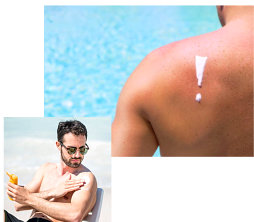 Many of us enjoy the sensation of sun on our skin. We feel happier, more energised and healthier when we’re sun-kissed. However, before we expose ourselves to those UV rays we need to make sure we’re protecting our skin.
Many of us enjoy the sensation of sun on our skin. We feel happier, more energised and healthier when we’re sun-kissed. However, before we expose ourselves to those UV rays we need to make sure we’re protecting our skin.
Who’s at risk?
Everyone. People with fairer skins are more likely to suffer damage from sun exposure but even people with darker skins need to take measures to protect themselves. Skins that have been burnt before, even in childhood, will be particularly sensitive to exposure.
Protect yourself
Sunscreen
The Sun Protection Factor (SPF) is a measure of a sunscreen's ability to prevent UVB from damaging the skin. The higher the SPF, the higher percentage of protection against UVB rays. Sunscreen works best once absorbed so apply it around 20 minutes before heading outdoors and reapply regularly (every two hours).
Cover up
Hats can protect the scalp, ears and hairline and shade the eyes from sunlight. Tightly-woven clothing helps deflect UV rays better than thin cotton.
Sunglasses
Plastic lenses that offer 100% UV protection are the best choice. Sunglasses prevent the risk of cataracts in later life and also protect the delicate skin around the eye area.
Avoid midday sun
The sun’s rays are strongest between around 10.30am and 3.30pm so avoid being exposed during this time. If you are outdoors cover up, apply sunscreen and try and stay in the shade where possible.
Know Your Skin
“Changes to a mole or freckle can be a sign of skin cancer, which is why it's so important to see your doctor straight away. Early detection makes it easier to treat.” – nhs.uk
 Checking your skin
Checking your skin
You should check your skin every few months for any new moles that develop or any changes to existing moles. A mole can change in weeks or months.
Things to look for include:
- Uneven colouring
- Moles with an uneven or ragged edge
- Bleeding, itching, red, inflamed (swollen) or crusty moles
- Moles that get a lot bigger
A helpful way to remember what to look for is to use the ABCDE method.
Asymmetry: A normal, healthy mole is usually rounded because it grows evenly. This means it is symmetrical, with one side a mirror image of the other. The picture shows a melanoma that looks like it has grown at an uneven rate and is asymmetrical.
Border: Melanomas often have ragged or blurred borders or edges. Normal, healthy moles tend to be much rounder, with smooth, clearly defined borders. The picture shows two examples of melanomas with ragged, blurred borders.
Colour: A normal mole usually has one uniform colour, whereas melanomas are often uneven in colour. As the picture shows, a melanoma can have two or three shades of brown or black, or varying shades of red and pink. The darkening of a mole is a sign that it is possibly becoming cancerous.
Diameter: Melanomas are usually larger than 6mm or 1/4 inch (approximately the width of a pencil). But this is not a sure sign of malignant melanoma. A cancerous mole can be smaller than this, and a perfectly healthy mole can be larger.
Elevation or Enlargement: A melanoma will often change in size, shape and colour over time, and may become raised above the skin’s surface. Inflammation or swelling is another sign that you need to see your GP for a check-up. The original mole often remains the same size, while an area around or under it appears to spread or swell. Any new symptoms – such as bleeding, itching or crusting – may also be caused by melanoma.